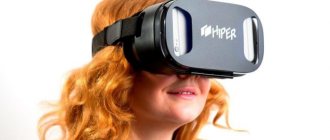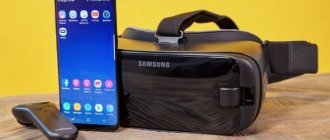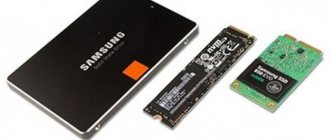The first smart glasses capable of simultaneously implementing three separate functions - keeping a video diary, combining the virtual and the real, creating augmented reality, connecting to the Internet - were presented by Google in 2012. Now these glasses can compete with products from Intel and Apple.
For such a short time of its existence, as for a revolutionary invention, smart glasses have not become a commercially successful product and are not yet in mass demand. However, the producers did not count on this. At least for now, the Google Glass project is positioned as a prototype of a device that needs to be evaluated not in the context of its capabilities, but from the point of view of possible prospects.
What were the very first smart devices - smart glasses?
Smart glasses are augmented reality devices that improve the perception of received information. The simplest example of augmented reality is the mixing of real and fictional objects in video clips, movies, reports (a digital indicator in the form of an arrow indicating the exact location of the events that occurred). The first Google Glass smart glasses were a headset based on the Android operating system, with a camera capable of recording high-quality video. The second version of Google Glass added a built-in mono earpiece. The design of the gadget is simple - a metal-plastic bezel with a thicker block of electronic filling.
How do smart glasses work?
Interaction with the gadget is carried out through voice commands. In Google Glass, this is the “Ok, glass” command. Just say it, and the necessary applications will start working. The device also allows you to recognize gestures; there is a touchpad on one of the arms. The user receives the image using a miniature screen. The gadget can also identify some objects. For example, identify a plant variety, suggest its name, determine the brand and model of shoes that glasses can help you order in an online store. Knowing the user’s location, they can offer him the best routes, addresses of stores and cafes nearby.
Technical characteristics of smart glasses that you need to pay attention to when choosing:
- characteristics of the built-in camera, screen resolution;
- processor, amount of built-in and RAM memory;
- Bluetooth equipment, Wi-Fi, type of operating system;
- control - voice commands, gestures, touch panel;
- device weight, battery capacity;
- design, equipment (silicone nose pads, charger, cable for connecting to a computer, sun protection
- lenses that can be attached to glasses, etc.).
Essentially, smart glasses are a computer enclosed in the shell of glasses. When using the device for the first time, the user is asked to adjust the position of the glasses so that the projected image is clear. Google Glass is controlled by voice commands and a touch panel that recognizes gestures. Smart glasses can also make, receive calls and send SMS messages.
Is it legal to use smart glasses?
Probably everyone has encountered the fact that not all people allow themselves to be filmed. If you have a camera or smartphone in your hands, it is almost impossible to take pictures unnoticed. But if you are wearing smart glasses, the task is simplified, because visually they are no different from a regular accessory “without brains”.
When the first Google Glass hit the market, a concerned public was outraged at the prospect of widespread use of secret filming and photography. For example, many restaurateurs immediately introduced a ban on wearing smart glasses on their premises.
Russian intelligence services have no complaints about smart glasses yet, but skeptics believe that there will be bans. They say that such a fate awaits, for example, glasses from Apple. Their sale will most likely be banned due to their similarity to regular glasses. The accessory falls under the definition of a “spy device.”
Smart glasses are a kind of computer, only it is presented in the form of an accessory we are familiar with. Unlike a smartphone, you don’t need to hold it in your hands, which means that using new technologies becomes even more convenient. Once the gadget becomes more accessible, it will certainly gain more popularity.
The use of smart glasses - what are they for?
Manufacturers of smart glasses are doing everything possible to ensure that their devices are as convenient and useful as possible for consumers. Such gadgets can be useful both in everyday life, for example, when preparing an original dish according to a recipe, which can be viewed directly from the glasses screen, and for athletes who have access to real-time information about heart rate, running speed, etc. d.
In addition to athletes, smart glasses have already been highly appreciated by business representatives and managers who are in dire need of a convenient and fast way to communicate, receive and transmit relevant information. Real-time filming is relevant for firefighters, journalists, rescuers, and law enforcement officers. When choosing the optimal model for themselves, consumers need to carefully study the characteristics of the device and the recommendations of manufacturers who produce smart glasses specifically for business, industry, sports, and for bloggers who record their daily lives using digital devices and post this data on social networks.
Those same Lavle glasses with auto-darkening. Product from the category of expectation - reality
I received my auto-dimming glasses here just now, one of which I myself once advertised. In general, forgive me those who bought it, because I rubbed some kind of bullshit into you. I honestly believed the renderings and reviews of real people when I made this order. I even imagined myself walking down the street doing street magic outside of Hogwarts. But in the end I got a harsh reality, and not my imaginary wishes. But the packaged glasses are 10 out of 10, so you wouldn’t be ashamed to give them as a gift to some geek. And then it’s his problem.
The entire set is huge and includes the following items: • the packaging itself • auto-darkening glasses • soft case • hard case • cleaning cloth • instruction manual • greeting cards from the seller • card for checking the polarization
The glasses themselves look similar to those sold at the nearest FixPrice. They are made of dark gray plastic with LCD lenses. The frame is quite large and does not suit everyone.
The dimensions of the glasses are as follows, from edge to edge - 13.4 cm, length and width of the lens - 48 * 39 mm, length of the temples 12.6 cm. On the right temple there is an emblem and the name of the manufacturer, in our case Lavle. There are 2 controls on the outside of the temple, +\- for changing the degree of darkness and controlling the glasses in general. They are not pressed very clearly, and the sizes are such that you constantly have to look for them.
On the left is an indication of the ability of polarization and its significance. There is also some information about the lenses. There is a battery compartment on the outside; a CR927 at 3V is used to power the glasses.
The nasal septum is made of a separately removable element. In principle, the elastic bands are soft and do not put pressure on the nose.
Before plunging into the incredibly interesting world of glasses, let's look at the accessories. The hard case is sewn very high quality, with the manufacturer’s name on the front. The material inside is quite soft, so it can be used for your favorite glasses. A soft case, also known as a transport case, for those who don’t like hard cases. A cloth for cleaning LCD lenses with an emblem, a spare battery and a tag for checking the polarization. By the way, let's find out right away if it is. And she seems to exist.
Now you can take the glasses apart. To do this, take the Wiha kit and use the smallest Phillips screwdriver. The screws are disposable and their edges are licked off during the unscrewing process. Before complete disassembly, it is advisable to also remove the arms. They are removed by twisting and squeezing out the pins.
Next, unscrew all the screws around the perimeter and unclip the two halves of the glasses. After which access to the magical insides of the glasses opens. The lenses have contacts soldered to each other, as well as to positive and negative wires. Soldering level - Chinese God. The wires are similar to those used in small equipment in a rag braid. The lens thickness is 1.5mm, fingerprints remain quite easily.
On the left side there is a small pocket for the battery, on the right there are buttons and a microcircuit. There is no marking on it. In general, the interior decoration of the glasses leaves much to be desired.
We put all the elements back together, spit on the torn edges of the screws, but still screw everything into place. Let's move on to testing. If you look at the render, it is indicated that the change in transparency from light glasses to almost black occurs in several steps, namely 7. Although the same instructions indicate from 5 to 7, perhaps the manufacturer himself cannot count the number of these steps. The first time you press the + key, the glasses turn on, the lenses flicker once and go into automatic mode. No matter how many times I checked them, from a bright lamp to sunlight, there was no change. Perhaps you forgot to add a light sensor. But in manual mode everything works, but not as stated. To help you understand, please take a look at the animation:
And finally, examples of the weakest and strongest dimming mode on me. Can you guess where it is?
In general, glasses from the category of expectation are reality. Happy shopping everyone! Well, I'll give glasses to someone for the upcoming holidays.
What do manufacturers offer? New and popular models of smart glasses
Google's invention allowed other manufacturers to also start experimenting in this area, and they were successful. Nowadays, consumers who are actively interested in new technologies and “smart” gadgets have access to a wide selection of smart glasses with different characteristics and functionality. Google continues to produce smart glasses, updating their versions for free. Also, such digital products are of interest to Intel and Apple, which have already made a breakthrough in the market by taking into account some of the shortcomings of Google Glass and developing concepts for absolutely revolutionary devices.
Thus, Intel released the first smart glasses, Intel Vaunt, which look no different from regular glasses. They can even be equipped with prescription lenses as well as sun protection lenses for long-lasting, comfortable wear. The glasses model is lightweight, and the electronics and batteries are placed in such a way that there is no pressure on the nose and ears. All electronics are located in the arms, an Intel chip is used, and a three-dimensional prismatic design is built into the lens. An image adjustment is made during the first use of the device, which takes into account the user's interpupillary distance. Such smart glasses do not interfere at all with seeing the world around us, since the display itself is invisible if information is not displayed on it.
What smart glasses, besides the well-known Google Glass and Intel Vaunt, are of interest to consumers? The most popular glasses models - features:
- GlassUP - the device is aimed at the interests of ordinary users, runs on the Linux operating system and is widely used in the industrial sector;
- Vuzix Blade 3000 - the gadget is equipped with an HD camera, a motion sensor, a touch panel, Wi-Fi and Bluetooth, an Android operating system, the device allows you to make calls, receive information related to navigation, and interact with various social networks;
- Solos - glasses for sports, aimed at buyers who prefer an active lifestyle, athletes, cyclists who need to receive navigation instructions, as well as data on pulse, heart rate, etc.;
- Vue Smart Glasses are popular smart glasses, the first available devices running on Android or iOS, synchronized with a smartphone, controlled by gestures, the device has a wide range of capabilities: it can answer calls, play music; glasses are charged in a special case, like AirPods;
- Vuzix M300 is a model of interest to representatives of specialized industries; the device allows workers to quickly receive hints and additional information about products and scan QR codes.
Apple is also developing its own version of innovative augmented reality glasses. The new product, like all the brand’s products, is eagerly awaited by the company’s followers. According to insider information, smart glasses will have an independent display and their own operating system.
Google's second attempt: why it's too early to bury smart glasses
All this, together with the rather high price of the device, $1.5 thousand, led to the fact that there was no significant demand for glasses. Google froze the project at the test sales stage in 2020. During 2012 and early 2013, the company sold only 10 thousand Google Glass to a limited number of people it selected. The devices were then sold only to those recommended by glasses wearers. According to analysts, no more than 250 thousand such gadgets were sold worldwide, although at the beginning of 2013 the research company Business Intelligence predicted that in 2014 2.5 million people would own glasses, and by 2020 their number would exceed 20 million
The partnership program for software developers for smart glasses was also discontinued, which caused additional dissatisfaction among companies that had invested in developing software for future Google Glass buyers.
Read on RBC Pro
How to become a Speaker: advice from re:Store founder Evgeniy Butman How to manage talent in the era of “large-scale rebellion” - part I Bill Gates - about the madness of conspiracy theorists and the new Steve Jobs Strategy of Ivanushka the Fool: how a top manager can get out of a dead end in 9 steps
Life after marketing death
Having curtailed sales of Google Glass, the company did not stop the development process, reasoning that if smart glasses were not needed by ordinary users, business clients might be interested in them: industrial and engineering companies, medical institutions, auto and aviation concerns, etc. Head of the Google project Glass Jay Kothari at the end of July 2020 published a text on his blog about how the company now sees the future of Google Glass.
For example, since 2014, GE Aviation (the aviation division of General Electric in the state of Cincinnati) has been using a corporate version of Glass Enterprise Edition smart glasses for aircraft repairs. Engineers and technicians wear glasses during repair operations—often in hard-to-reach areas of the aircraft, where human movement is limited and a smartphone or paper reference book cannot be reached. Information can be loaded into the glasses automatically, in this case animated instructions for performing certain actions. According to GE Aviation, which Kothari cites, using Google Glass improves work efficiency by 8-12%.
For two years, the capabilities of Google Glass were tested by about 50 companies selected by Google, including DHL, Boeing, Volkswagen, as well as one of the largest networks of medical institutions in the United States, Dignity Health. And farm equipment company AGCO uses the glasses both to help workers review machine assembly instructions and to conduct inspections of finished products. According to AGCO, overall assembly time was ultimately reduced by 25% and time spent on inspection by 30%.
DHL uses glasses to sort mail. A courier service employee, having received a new parcel, can clarify what needs to be done with it without having to put it aside or open a directory. This made it possible to increase the efficiency of operations at this stage of parcel processing by 15%.
Healthcare company Dignity Health uses Google Glass when seeing patients. A doctor wearing glasses communicates with a person who has come for an appointment; a recording is made; the data can be sent to another specialist and filed with the patient’s medical record. The company's doctors found that as a result of using Google Glass, the time they spent filling out medical records and other necessary documents was reduced from 33 to 10% of their total working time.
Analysts predict a bright future for Google's brainchild. A recent Forrester Research report predicted that by 2025, about 14.4 million U.S. manufacturing workers will wear smart glasses. According to MarketsandMarkets, by 2022 the market for smart glasses in the world (industrial and conventional together) will be $8.13 billion with an average annual growth rate of about 19%.
Over two years of testing glasses at various enterprises, Google found out what was missing from the product for corporate users. The new version of the device can be worn with safety glasses, has interchangeable lenses and a large camera button with an indicator showing that video is being recorded. Google Glass Enterprise Edition received updated hardware, including an improved 8 megapixel camera, a more powerful processor, faster Wi-Fi and increased battery life to eight hours on a single charge. Also, the device memory has been doubled, to 32 GB. The price increased slightly - to $1.8 thousand. For corporate clients, this price tag does not seem high.
For the same rake
It would seem that the failure of Google Glass in the consumer electronics segment buried the idea of “smart” glasses with a camera, but this did not stop Snap: in 2020, it launched Spectacles glasses, which allow real-time “streaming” of video to Snapchat. The glasses are sold through special machines, and in the first days of sales there were huge queues for them - at least that’s how Snap itself imagined the situation. After all, Spectacles are much cheaper than Google Glass - $130.
Sergey Brin (Photo: Carlo Allegri / Reuters)
In reality, it is premature to talk about the success of a new product. In May 2020, during its first-quarter earnings call, Snap CFO Drew Volero said the company generated $8.3 million in non-advertising revenue, most of which came from sales of Spectacles. That is, the company sold only about 60 thousand pairs of glasses in three months. Snap’s total revenue for the reporting period exceeded $150 million, so more than 90% of the company’s revenue still comes from advertising, although Snap itself already calls itself “the camera company.”
The problem is that IT companies can’t figure out why consumers actually need smart glasses. So Alphabet and many competitors are creating technologies that could make such glasses truly useful. For example, at the Google I/O 2017 conference, Google CEO Sundar Pichai introduced Google Lens, a smart camera for Android devices. Using Google Lens, by pointing your phone at a poster, you can get complete information about a film or concert; a smartphone with Google Lens can “tell” about an architectural monument a person has seen, find the name of a plant on the Internet, or simply read the Wi-Fi password on an advertisement in a cafe .
Samsung has installed the Bixby solution in the latest model of Galaxy smartphones, which, in particular, allows you to point the camera at a product on a store shelf and automatically see its price from online retailers, or point the smartphone at a plant and get a comprehensive report on its properties. All these technologies could make smart glasses more than an expensive toy for electronics geeks.
Alphabet itself continues to believe in this project. “None of us have given up on the idea that Glass will become less and less intrusive over time and that more and more people will use it, but we won't try to predict what their path will be. That’s where we got it wrong last time,” Astro Teller, head of Alphabet’s innovation wing, told Wired in July.
Ultimately, the sales driver may be the corporate market: having appreciated the benefits of smart glasses at work, people may want to wear them all the time.
View from the outside
“Business tries to minimize the influence of the human factor”
Pavel Gontarev, CEO of SAP CIS
“Developments in the field of AR/VR (augmented and virtual reality. - RBC) have been underway for 15 years, but only in the last two or three years have they begun to be widely used in industry, retail, transport, education and other areas.
Companies in the CIS and Russia greet these developments more coolly for obvious reasons: they expect results and “best practices” from colleagues from abroad, where competition between manufacturers and vendors in this area is extremely high. But nevertheless, we see great interest from Russian customers: the price of such technologies today is quite acceptable due to competition in the market for various devices, the technical shortcomings of gadgets are minimized, programming and implementing the technology is now much easier.
Solutions using augmented reality are especially in demand in industries with an increased risk of injury or danger to life: in the control of heavy equipment, aircraft, control of robotic equipment, medicine, etc. For example, in the aviation industry, augmented reality is used for the convenience and safety of testing, training and use of aircraft. To do this, AR is built into the pilot's helmet or glasses so that he can see the world around him with augmented information, without being distracted by individual instruments on the panel. Augmented reality in construction and architecture allows you to see the final result at the design stage, thereby reducing risks in the production process. For the medical field, a scenario has been developed where the system shows emergency data on the display right in front of the doctor’s eyes, and also displays the patient’s card there as soon as the doctor enters the room to see the latest test results and treatment prognosis.
Over the past few years, we have created two solutions - SAP AR Warehouse Picker and SAP AR Service Technician - to work with warehouse accounting and personnel management systems, respectively. Using them, a worker can request information about a specific object, see tasks and instructions for collecting an order directly on the glasses screen. The built-in software scans QR or barcodes on objects and verifies the correctness of positions, and can also download orders into its memory for the entire working day of the employee. Smart glasses with AR functionality are also used in repair and transportation work. The instructions are visualized on the lenses of the glasses, telling you step by step what the specialist needs to do, allowing you to work in hands-free mode, which increases not only the safety of the process, but also its speed. Thus, business is trying to minimize the impact of the human factor, without replacing workers themselves with expensive industrial robots and preserving jobs for staff.”
“We will be talking about multi-billion dollar markets”
Sergey Negodyaev, director for work with portfolio companies of IIDF
“If Google's new solution is positively assessed by engineers, we will be talking about multi-billion dollar markets. Augmented reality technologies make it possible to solve a whole range of production problems, from personnel training to the ability to diagnose a potential breakdown and take timely measures. However, it is important to consider that the engineering industry is quite conservative, so innovation is difficult to implement. There are already cases of introducing VR technologies into industry; one example is the IIDF portfolio company Holo group, together with Micromine, a developer of solutions for the mining industry, creating virtual models of deposits using augmented reality technologies.”
"Technology can be useful"
Denis Shvetsov, director of development of the network of clinics “Doctor Nearby”
“Now many people are thinking about redistributing the doctor’s time from completing documentation in favor of working with the patient.
And this technology can be useful if integrated with medical information systems. I have already heard more than once about projects for recognizing the speech of a doctor and a patient at an appointment to simplify the process of filling out medical documentation - glasses could be an interesting continuation of these ideas, they will work not only with sound, but also with images. I think that glasses can be used not only in face-to-face clinics, but also when providing medical services to patients at home, when access to medical information is limited.” SaveSave











